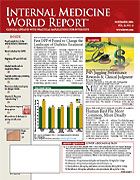Publication
Article
Internal Medicine World Report
Truncated Antibiotic Therapy Works in Mild-to-Moderate CAP
Author(s):
From the Interscience Conference on Antimicrobial Agents and Chemotherapy
SAN FRANCISCO—New data presented at the Interscience Conference on Antimicrobial Agents and Chemotherapy show that shorter antibiotic courses can be as safe and effective as longer regimens in adults with community-acquired pneumonia (CAP), and that a new glycylcycline may be a valuable treatment option for this patient population.
Benefits of Short-Term Therapy
Adults with mild-to-moderate CAP may be safely and effectively treated with an antibiotic course of ≤7 days. This would have the added benefit of reducing patient exposure to antibiotics and thus combating antibiotic drug resistance, decreasing individual and overall costs, and improving patient adherence and medication tolerability.
Current estimates suggest that 2 million to 3 million cases of CAP occur each year in the United States, at an annual cost of >$20 billion. For such a common illness, there is still surprisingly little consensus on the appropriate duration of therapy.
This systematic review included randomized controlled trials that compared short-course (≤7 days) and extended-course (≥7 days) regimens, based on a search of CENTRAL, Medline, and Embase for articles published from 1980 through November 2005.
A total of 15 trials involving 2796 patients matched the study criteria. Ten of the short- and extended-course regimens used azithromycin (Zithromax), 2 used beta-lactams, 2 used fluoroquinolones, and 1 used ketolides.
Overall, no differences were found in the risk of clinical failure between the short- and long-term regimens, nor were there any differences in rates of bacteriologic eradication or mortality. A subgroup analysis found a trend toward favorable clinical efficacy for the short-course regimens for all 4 antibiotic classes.
“We need better guidelines for the appropriate length of time for antibiotic use in mild-to-moderate community-acquired pneumonia. So far, there have been no definitive studies looking at this particular subject, which has led to a myriad of recommendations by different medical societies and groups,” said lead investigator Jonathan Li, MD, of the University of California, San Francisco. “When we looked at the longer courses of treatment versus the shorter courses of treatment, there were really no significant differences in mortality or clinical successes.”
Dr Li said the practice of using longer courses of antibiotics has led to a number of unintended consequences, most notably, a rise in multidrug resistance. Population studies have suggested that the longer the course of antibiotics, the greater the risk of resistance.
“Shorter courses may mean fewer complications with side effects and so greater patient compliance,” Dr Li told IMWR. “By doing this study, we hope that new guidelines can be developed that may help better guide physicians. Primary care physicians in particular are often left to their own devices to try to figure out what is an appropriate length of treatment, and this is contributing to overall healthcare costs. We need a better framework for physicians.”
The study excluded patients with severe disease.
New Agent Shows Promise
Results from 2 phase 3 multicenter trials that totaled 846 patients showed that tigecycline (Tygacil) was slightly more effective than levofloxacin (Levaquin) for hospitalized patients with CAP.
The first agent in the glycylcycline class, tigecycline was designed to overcome the resistance mechanisms associated with tetracycline. Tigecycline has expanded, broad-spectrum, in vitro activity against many gram-positive, gram-negative (except Pseudomonas aeruginosa), anaerobic, and atypical respiratory pathogens. Tigecycline is currently approved for the treatment of complicated skin and soft-tissue infections and of intraabdominal infections.
The 2 studies compared tigecycline with levofloxacin in adults hospitalized with CAP. Patients were randomly assigned to receive either intravenous (IV) levofloxacin 500 mg every 24 hours (first study); 500 mg every 12 or 24 hours (second study); or tigecycline 100 mg IV initially, followed by 50 mg every 12 hours (both studies).
In the first study, after at least 3 days of therapy, patients in either group could be switched to oral levofloxacin at the investigators’ discretion. Treatment duration was 7 to 14 days in both trials. To be included in the results, the test-of-cure patient assessment had to occur from 7 to 23 days after the last dose of the study medication.
The coprimary end points were clinical response at the test-of-cure assessment in the clinically evaluable and in the modified intent-to-treat populations. Safety was analyzed in the modified intent-to-treat population.
Demographic characteristics and risk factors were similar in all groups. In the clinically evaluable population, cure rates were 89.7% with tigecycline and 86.3% with levofloxacin. In the intent-to-treat population, the respective cure rates were 81% and 79.9%. Noninferiority was shown in both populations.
The length of hospital stay was comparable, regardless of medication used, and averaged 6.3 days.
Nausea was 3 times more common with tigecycline than with levofloxacin (20.8% vs 6.6%) and vomiting was about 4 times more common (13.2% vs 3.3%). Discontinuation rates because of adverse events were similar.
“The need for a new option is especially critical, as many strains of the most common bacteria causing CAP are now resistant to certain antibiotics and can complicate treatment,” said coinvestigator Thomas File, MD, chief of infectious disease services for Summa Health System, Akron, Ohio.
“This is potentially a very serious infection, and these new data suggest this agent will be effective against the key pathogens associated with pneumonia that require admission to the hospital,” Dr File told IMWR.





